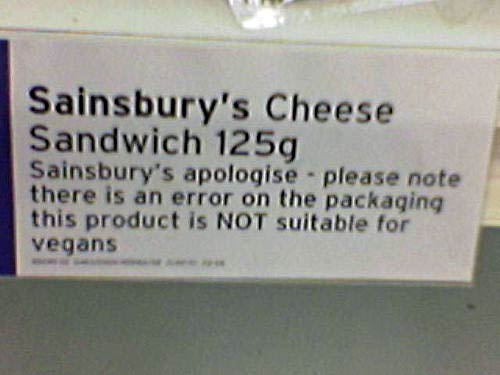What Are We Really Eating?
By Madhava Smullen | Jan 25, 2008

We live in a world of enticingly packaged, processed foods where nobody really cares what they’re eating, so long as it looks good. As a child, I remember seeing a guest on a TV chat show say that they were allergic to various products, and therefore had to check the ingredients on everything when they went shopping. “Oh my God!” the host exclaimed in horror. “That must be such a pain! I could never do that!”
More recently, I was traveling in California with some friends and decided to visit Universal Studios in Hollywood. When hunger struck, we searched for the most vegetarian restaurant we could find and discovered one with a delightful buffet-style line featuring a variety of salads, pasta and pizza.
The girl at the counter filled up our plates with pasta once she’d let us know, none too confidently, that it didn’t contain eggs.
Then the fun really started.
“Do you know if there’s animal rennet in the cheese?” My friend Janmastami asked.
The girl looked blank. He tried to rephrase the question. “What is the cheese made with?”
This time she stared at him with an expression reserved for the severely mentally retarded. Her jaw slackened a little. Her eyes opened wide.
“Cheese is made with milk,” she said. “Milk comes from a cow.”
If only it were that simple. As a vegetarian, I may find this kind of routine ignorance funny – at least in retrospect – but it doesn’t inspire confidence in our eating establishments. Food companies themselves, while presenting a slightly more sophisticated front, aren’t much better. For a start, there is no law in any country that requires retailers to mark their products as vegetarian.
When you do find a “vegetarian” label, it’s simply a voluntary practice on the part of the manufacturer, and doesn’t reflect any universally agreed upon standard. Different manufacturers have their own opinion on what is or isn’t vegetarian, so even if a product announces to you that it’s fine for you to eat, it may actually contain, for example, animal-derived glycerine. Certain labels, like that of the Vegetarian Society in the UK, are reliable – but ISKCON devotees must be sure to double check, as the manufacturers generally consider eggs suitable for vegetarians.
So what can you do? Shock that poor TV host from the eighties, and check your ingredients every time. It’s the only way. Checking once and creating a list of “safe” products isn’t reliable, as manufacturers often change the ingredients in a product without warning – for instance, a rennet-free cheese may start using rennet again at any time.
But you’re still not in the safe zone yet. When you do check your ingredients, you’ll probably find that most of them might as well be written in Arabic. Packages don’t inform you that your ice-cream contains a gelling agent derived from animal ligaments, skins, tendons, bones and hooves. No, that would take up far too much space, and ruin your appetite. So instead, they use a neat little word like “gelatine.” You might be surprised to know how many ISKCON members don’t know this – a disturbing thought.
Here are some more common animal ingredients you should watch out for:
Cochineal, also known as E120, is a red dye often used in ice-cream, yogurt, glacé cherries, jams and drinks. Sound delicious? You’ll stop licking your lips after you’ve heard that it’s made from the crushed female un-hatched larva of the Cochineal beetle.
Animal rennet is an enzyme made from the stomach of calves and lambs, and is often used in cheese. Fortunately, it’s usually listed in ingredients as “animal rennet,” since rennet can also be made from vegetables.
Gylcerine is a type of animal fat that is often blended with vegetable fats. Many soap products contain it, and do not always state whether it is plant or animal-based. If in doubt, contact the manufacturer. Glycerine is also found in some chewing gums.
Lecithin is found in egg yolks, the tissues and organs of many animals, and some vegetables such as soybeans and corn. It’s often used in butter and margarine, and other foods high in fat and oils. If it’s vegetarian, the ingredients will state “Soy Lecithin.” Luckily, Lecithin is usually made from soy these days.
Beware of the phrase “Natural flavors,” on a product. Sounds friendly, doesn’t it? But often, these will be derived from beef or other meats. Contact the company and ask them what they use in their natural flavors. They may not always tell you, but the more people that do this, the more they’ll be likely to start making it available knowledge.
The world of processed foods is a strange one that seems to be intent on making sure you don’t know what you’re putting in your mouth. Today’s world, as Srila Prabhupada’s guru Bhaktisiddhanta Sarasvati so succinctly put it, is “No place for a gentleman.” But while you’re here, you would do well to brush up on your knowledge of animal ingredients.
PETA (People for the Ethical Treatment of Animals) have a comprehensive list that should get you started. Good sources of additional information are the Consumer’s Dictionary of Cosmetic Ingredients and the Consumer’s Dictionary of Food Additives, available at most libraries or bookstores. And of course, if you have a question regarding an ingredient in a product, just call the manufacturer.














